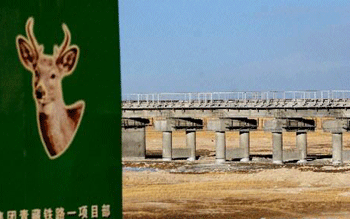| Tools: Save | Print | E-mail | Most Read |
| 3 Challenges to Construction of the Qinghai-Tibet Railway |
| Adjust font size: |
The Golmud-Lhasa section of Qinghai-Tibet railway line is 1,142 kilometers long, with 960 kilometers of it sitting at 4,000 meters above sea level. The protection of the fragile ecosystem, the lack of oxygen at high-altitude and the perennial frozen ground were three of the challenges met in the construction of the line. Plateau ecosystem not markedly affected The Tibetan Plateau is the source of many rivers and home to many species of plants not found anywhere else in the world. The plateau ecosystem is primeval, peculiar and fragile. Before the start of the project experts from the State Environmental Protection Administration (SEPA), Ministry of Land and Resources and Ministry of Railways conducted a thorough investigation into the ecosystem along the length of the line and worked out detailed environmental protection measures. One billion yuan was earmarked to protect the ecosystem as construction work progressed.
Cai Fan, deputy Party secretary of the Headquarters for Qinghai-Tibet Railway construction, said that the "fragile ecosystem" was taken into consideration even in the early planning stages. The design was drawn up to avoid locations that would affect the environment of nature reserves. Construction sites were selected and designed to ensure that vegetation was not destroyed. Construction firms signed "responsibility contracts" with environmental protection authorities in Qinghai Province and Tibet Autonomous Region accepting their authority. The Qinghai-Tibet Railway travels through two state-level nature reserves – Hoh Xil and Qiangtang. To protect wildlife, 25 migration passages were built beside the railway. According to electronic monitoring in June 2005, a group of Tibetan Antelopes migrated freely through the passages. Investigations by SEPA and other authorities show that frozen soil, vegetation, wetlands, water quality in rivers along the railway have been effectively protected and the plateau ecosystem was not markedly affected. No deaths from high-altitude oxygen deficiency About 85 percent of the Qinghai-Tibet Railway is located in places where the altitude is over 4,000 meters, the annual average temperature is below zero and the air oxygen content is only 50 to 60 percent of that in lowland areas. These locations were described as the "forbidden zone" for human life due to the lack of oxygen, the incredible sandstorms, strong ultraviolet radiation and the regular outbreak of diseases. To tackle health problems, a medical insurance system was put in place, according to Cai. A total of 115 medical facilities were set up along the railway, staffed with more than 600 medical professionals. Workers had access to rapid and effective medical treatment as well as regular health checks. They also enjoyed regular breaks from work to rest in low-altitude areas.
When working in the Kunlun Mountain Tunnel – 4,600 meters above seal level – workers have to carry a 5-kg oxygen cylinder to help with their breathing. Around 120,000 cylinders of oxygen were used in just one year's construction. China Railway 17th Group Co Ltd installed oxygen-supply pipelines in workers' dormitories. During the construction in Fenghuo Mountain Tunnel – 4,905 meters above sea level – China Railway 12th Group Co Ltd built an oxygen-producing station to "feed" the tunnel. The oxygen content in the tunnel reached 80 percent. Seventeen such stations were built along the railway line equipped with 25 high-pressure oxygen cabins which provide at least two hours of oxygen for each worker. A total of 453,000 cases of sickness were reported during the construction period, including 427 cases of hydrocephalus and 841 cases of pulmonary edema, but no deaths were recorded. "Museum" for frozen soil engineering The volume of soil expands while freezing and reduces when thawing out in the summer. Affected repeatedly by this phenomena cracks can be seen in roads and houses. With low and high altitude, strong sunlight and frequent geological movements, the frozen ground on the Tibetan Plateau is extremely complex.
Borrowing ideas from research findings and successful experiences of other countries, Chinese experts adopted creative measures to deal with frozen soil engineering difficulties. Areas of frozen soil where geological structures are complicate were avoided. Bridges were built instead of roads in areas where the ground conditions were unstable. Twenty other frozen earth engineering problems were solved during the construction by taking creative measures. Zhang Luxin, leader of the project's expert consultancy team, said the possibility of large scale damage to the railway resulting from the frozen ground is remote. Trains operating on the line can travel at 100 kilometers per hour and it will be operational all the year round. (China.org.cn)
|
| Tools: Save | Print | E-mail | Most Read |
 |
| Related Stories |
|
Product Directory China Search |
Country Search Hot Buys |


